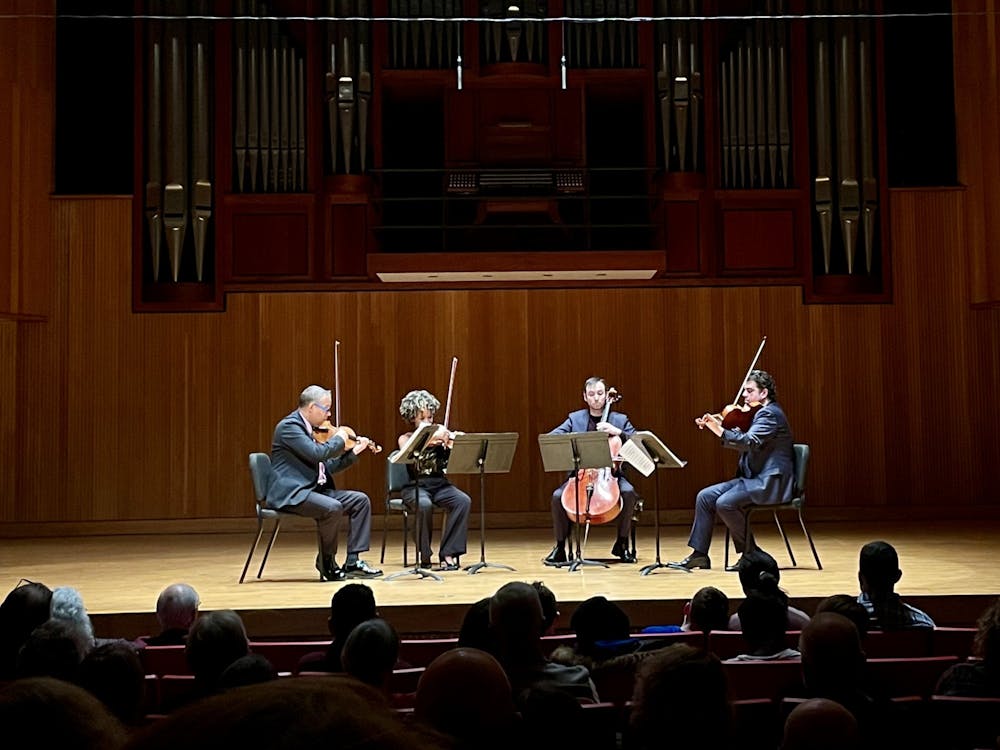The Harlem Quartet delivered an immersive performance full of energy and humor to a packed Lippes Concert Hall last Saturday. The Grammy-winning string quartet played a uniquely diverse program that spanned several centuries, genres and styles, with a special focus on composers of color and female composers.
The group was formed in 2006 by finalists of the Sphinx Competition, which is for young Black and Latino string players. Since then, the Harlem Quartet have been devoted to promoting diversity in the world of classical music by exposing new audiences to composers from historically overlooked groups.
The program kicked off with “Strum,” a piece by contemporary violinist and composer Jessie Montgomery. The song began with the gentle, rhythmic plucking of strings, immediately quieting the chattering audience. A dynamic piece, the music swayed between loud, frenetic chaos and moments so quiet one could hear a pin drop. The song culminated in a triumphant flourish, as the musicians exchanged knowing glances with one another and lifted their bows in the air.
The next piece, “Lyric Quartette, Movements 1 & 2,” was written by William Grant Still, a leading figure in the Harlem Renaissance and the first African American to conduct a major American symphony orchestra.
Cellist Felix Umansky introduced the piece as a “character sketch” of two people in Still’s life. The two movements, “The Sentimental One” and “The Quiet One,” were lush and romantic.
The night took a turn when the group pivoted from classical to jazz, performing two movements from “At the Octoroon Balls,” by Wynton Marsalis. Second violinist — UB faculty member Melissa White — introduced the first section, “Rampart Street Row House Rag,” with much enthusiasm, asking the audience to imagine the number playing in a smoky old saloon.
“Sometimes it’s funny, but if it’s not, it’s OK — you don’t have to laugh,” White said.
The movement, a bouncy pastiche of ragtime music, did indeed draw some amused giggles from the crowd. But it was the second movement, “Hellbound Highball,” that seemed to truly delight the audience.
The chaotic, unconventional piece is a musical interpretation of a train headed for a station in hell. To bring this concept to life, the musicians used different string techniques to mimic the various sound effects of that doomed train.
White plucked the strings of her violin to create the sound of the train’s bells, while violinist Ilmar Gavilan imitated the train’s brakes with a screeching, atonal flourish.
Their instruments combined to represent the quick, repetitive chugging of the train’s engine. Toward the end of the piece, the musicians abruptly stopped playing to bring their feet to the floor in a single, synchronized stomp. The cacophony of the performance aroused a wave of laughter from the audience, with the musicians smiling as they played.
“I don’t know if you know this, but we like to have fun while we play,” violist Jaime Avador said after the piece’s conclusion.
Further proving the group’s versatility, they launched into an Afro-Cuban number, “Cuarteto En Guaguancó,” composed by Gavilan’s father, Guido López-Gavilán. The piece was anchored by Umansky’s cello, which he plucked like an upright bass. The group kept things upbeat and danceable with percussive embellishments, rhythmically tapping the bodies of their instruments.
After intermission, the quartet finished off the night with two pieces: “Entr’acte” and “String Quartet in E-Flat Major.”
The latter piece was composed by Fanny Hensel-Mendelssohn, the lesser-known sister of Romantic composer Felix Mendelssohn. Gavilán’s introduction to the piece was touching, describing it as something Mendelssohn composed for herself to enjoy, “dancing around her room [and] not caring how she looks.”
“We think this piece deserves to be heard not because of her family connection, but because it’s beautiful,” Gavilan said. “It’s for you, for me, for everyone… it’s gorgeous.”
The group received a standing ovation as they left the stage, prompting them to return for an encore: a joyous rendition of Duke Ellington’s iconic “Take the ‘A’ Train.”
The Harlem Quartet’s performance at UB was engaging enough to impress even an audience member thoroughly unacquainted (or even uninterested) with classical music. There’s a commonly held notion that the genre is inaccessible, stuffy or too high-brow. The group challenged this stereotype with great enthusiasm.
The spring concert season at Lippes Concert Hall continues next Monday with a performance of Beethoven’s string quartet cycle from the Parker Quartet.
Meret Kelsey is the senior arts editor and can be reached at meret.kelsey@ubspectrum.com
Meret Kelsey is an assistant arts editor at The Spectrum.





